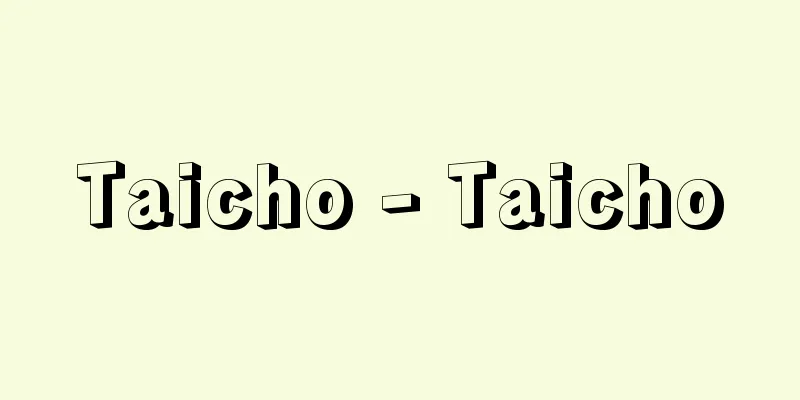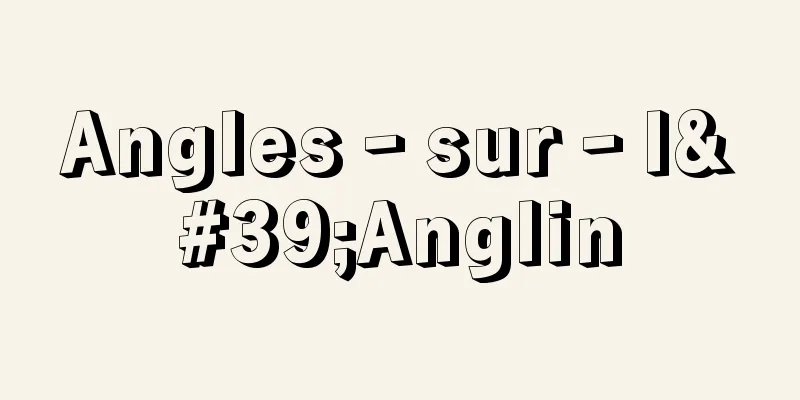Chinkin - Chinkin

|
A type of lacquerware decoration. A pattern is engraved on the lacquered surface with a carving knife, raw lacquer is rubbed in, and before it dries, gold leaf or gold powder is carved and pressed into the grooves with cotton to create a gold stripe pattern. When silver leaf is used, it is called shingin. This technique originated in China's sokin (also written as jin or chuokin), and its time of origin is unknown, but documents from the Southern Song Dynasty (13th century) state that it was produced. Currently in Japan, there are three sutra boxes with lacquer inscriptions that are said to have been produced in 1315 by the Jin and Song families of Hangzhou, Zhejiang Province, at Seiganji Temple in Fukuoka City, Jodo Temple in Onomichi City, and its branch temple Komyobo, and these are the oldest works with inscriptions. The structural format of these sutra boxes is exactly the same, and they also share the same intricate composition of inlaid gold motifs of twin birds and clouds within lattice spaces, surrounded by floral motifs. The Cloud and Phoenix Spear Gold Sutra Box handed down at Todaiji Temple has more detailed depictions of the motif, with the outline and interior carved with different lines, giving it a rich variety of thickness and thinness, and is topped with a green lacquer coating. According to the Tekkakuraku, a book from the early Ming Dynasty (late 14th century), the designs were based on themes such as natural landscapes, flowers and birds, architecture, and historical figures, suggesting that pictorial expression was also used at the time. The name Chinkin was first mentioned in the "Teikin Orai" (written in the late 14th century) where a Chinkin incense container was mentioned, and it can also be seen in the "Kanmon Gyoki" (entry for December 25, 1421) and "Inryoken Nichiroku" (entry for June 29, 1435) in the 15th century, but these cannot necessarily be said to have been made in Japan. A Japanese Chinkin with a clear date is the Houou Kirimon Sutra Box (1538) at Kangakuin Temple in Gifu Prefecture, and relics without inscriptions thought to have been made in the same period include the Phoenix Chinkin Hand Box (Important Cultural Property, Shirayamahime Shrine in Ishikawa Prefecture) and the Horai Chinkin Hand Box (Tokyo National Museum). In the Edo period, excellent works were made in Nagasaki during the Kyoho era (1716-1736), and in the Kansei era (1789-1801), the doctor Ninomiya Toutei of Edo produced excellent works, and the "Kogei Shiryo" (1877), published in the Meiji period, records that they also began to be produced in Wajima, Noto Province (Ishikawa Prefecture). Currently, they are known as a Wajima specialty, and similar products are also produced in Aizu-Wakamatsu and Kawatsura, Akita. [Goka loyal retainer] [Reference item] |(1) A pattern is engraved on the lacquer surface with a needle. (2) The lacquer is rubbed in and gold leaf is placed on top, or gold powder is sprinkled on top. (3) The gold leaf is pressed into the surface with cotton and then wiped away, leaving the gold leaf in the engraved pattern. ©Shogakukan "> Chinkin technique Source: Shogakukan Encyclopedia Nipponica About Encyclopedia Nipponica Information | Legend |
|
漆器の加飾法の一種。漆塗りの表面に文様を彫刀で浮彫りし、生漆(きうるし)を摺(す)り込み、乾かないうちに金箔(きんぱく)または金粉を彫り溝の中に綿を使って押し込み、金条線の文様を表したもの。銀箔を用いたものは沈銀という。この技法の起源は中国の鎗金(そうきん)(金、創金とも書く)で、発生時期は不明で、南宋(そう)代(13世紀)の文献に製作が行われたとある。現在日本に、延祐2年(1315)浙江(せっこう)省杭州(こうしゅう)の金家と宋家とが製作したという漆書銘文をもつ経箱(きょうばこ)が福岡市誓願寺、尾道(おのみち)市浄土寺とその末寺光明坊に3点残り、これらが銘文のある最古の作品である。これら経箱の構造形式はまったく同一で、沈金の文様も格狭間(こうざま)の中に双鳥と雲文とを表し、その周囲を花文で埋めた緻密(ちみつ)な構図も共通である。東大寺に伝わる雲鳳(うんぽう)鎗金経櫃(きょうびつ)は、文様の描写がこれより細密になり、輪郭と内部が異なる線で彫られて肥痩(ひそう)に富み、上(うわ)塗りに緑漆がかけられている。明(みん)初期(14世紀末)の『輟耕(てっこう)録』によれば、図様は自然景観、花鳥、建築物、故事上の人物などをテーマとしたとあるので、当時は絵画的表現もなされていたと推測される。 沈金の名称は『庭訓(ていきん)往来』(14世紀後半成立)に沈金の香合(こうごう)が記されているのが初出で、15世紀には『看聞御記(かんもんぎょき)』(応永28年〈1421〉12月25日の項)や『蔭凉軒日録(いんりょうけんにちろく)』(永享7年〈1435〉6月29日の項)などにもみられるが、これらはかならずしも日本でつくられたものとはいえない。日本の沈金で年代の明らかなものは岐阜県勧学院の鳳凰桐文(ほうおうきりもん)経箱(1538)で、同時期の作と考えられる銘文のない遺品に、鳳凰沈金手箱(重文、石川県白山比咩(しらやまひめ)神社)や蓬莱(ほうらい)沈金手箱(東京国立博物館)などがある。江戸時代になると、享保(きょうほう)年間(1716~36)に長崎で、また寛政(かんせい)年間(1789~1801)に江戸の医師二宮桃亭(にのみやとうてい)が優れた作品をつくり、また明治に出た『工芸志料』(1877)には能登(のと)国(石川県)輪島でも製作され始めたことが記されている。現在は輪島の特産として知られるほか、会津若松、秋田川連(かわつら)でも同種のものがつくられている。 [郷家忠臣] [参照項目] |(1)漆面に文様を針彫りで表す(2)漆を摺り込んで金箔を置く。または金粉を散らす(3)綿で金箔を押し込み、ぬぐい去り、刻文の中に金箔が残る©Shogakukan"> 沈金の技法 出典 小学館 日本大百科全書(ニッポニカ)日本大百科全書(ニッポニカ)について 情報 | 凡例 |
<<: Wage - Chingin (English spelling) wage English
>>: Chen Yucheng (English name)
Recommend
Oxbow Incident
...He is famous for directing the aviation master...
Carlos III
1716‐88 The eldest son of Philip V and Isabella of...
Ahmad bin Said Albu Said - Ahmad bin Said Albu Said
…Since then, Britain has exercised exclusive infl...
Schedule
…In 1952, it was the site of the 15th Olympic Gam...
interval scale
…These analytical methods, along with regression ...
Eight heads - Yatsugashira
〘Noun〙① A cultivated variety of taro. Seven to nin...
Wolf-Pariza Star Chart
...In the 20th century, photographic atlases were...
creeping fescue
…It has become naturalized in various parts of Ja...
Improvement Department - Kandachime
〘Noun〙 (also written as "kamudachime") A...
Great circle
〘noun〙① A large circle. ② In mathematics, the circ...
Meiosis
…Since many cells that no longer divide enter G0 ...
Sluiceway - Himon (English spelling)
A culvert (ankyo) is a drainage channel that cros...
Tomo Kitabayashi
1886-1945 A social activist in the early Showa pe...
Kamiyaku [town] - Kamiyaku
This old town, located in Kumage District, Kagoshi...
Edinburgh Botanical Gardens - Edinburgh Botanical Gardens
… [Botanical Gardens of the World] Botanical gard...




![Sumoto [city] - Sumoto](/upload/images/67cbfaab0109e.webp)




